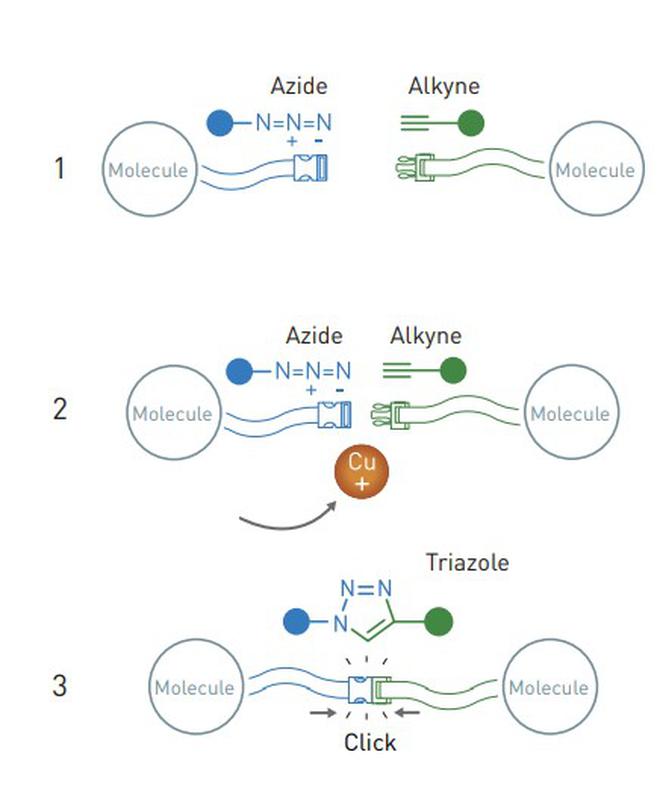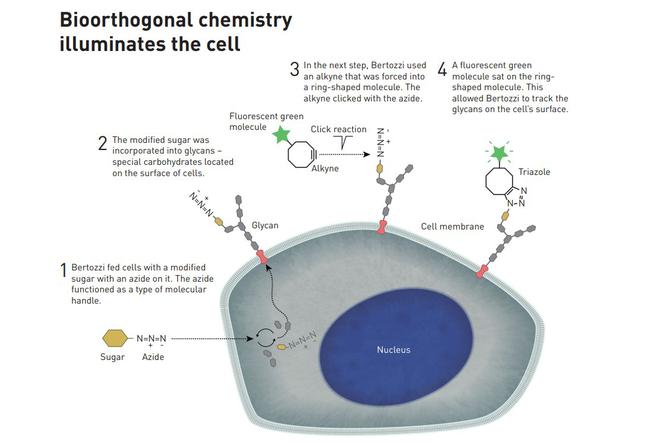The story so far: The 2022 Nobel Prize in Chemistry has been awarded to chemists Carolyn R. Bertozzi and K. Barry Sharpless from the U.S., and Morten Meldal from Denmark, for their work in the field of click chemistry and bioorthogonal chemistry.
Dr. Sharpless was the first scientist to work on what is today called click chemistry – a branch of science that explores the assembly of molecules. In fact, this is not his first Nobel Prize in Chemistry. He previously won the award in 2001.
Soon after, Dr. Meldal and Dr. Sharpless – independently of each other – presented the copper-catalysed azide-alkyne cycloaddition (CuAAC), a reaction that is now widely used in fields like medicinal chemistry.
The CuAAC reaction is an improved form of the azide-alkyne Huisgen cycloaddition, which was once called the “cream of the crop” among click reactions by Dr. Sharpless and other authors in a research paper published in 2001.
Dr. Bertozzi improved the field further by developing click reactions that work inside living organisms. These bioorthogonal reactions do not disrupt the normal chemistry of the cell.
The winners will be awarded 10 million Swedish kronor, to be shared equally between the three.
What is click chemistry?
In simple terms, click chemistry is a functional field where molecules snap together quickly and efficiently – literally like a click.
Dr. Sharpless talked about the field in the research paper in 2001, where he defined it as a “set of powerful, highly reliable, and selective reactions for the rapid synthesis of useful new compounds and combinatorial libraries through heteroatom links”. In the same paper, he talked about the need to develop synthetic strategies instead of trying to imitate naturally occurring compounds. He is of the view that even if click chemistry is unable to provide exact replicas of natural molecules, it can help find molecules that fulfil the same purpose.
According to Dr. Sharpless, a reaction should be able to occur in the presence of oxygen and in water for it to be called that of click chemistry.
The need for click chemistry
Replicating reactions that involve bonds between carbon atoms – that are vital to the existence of life – is expensive and often leads to side reactions and loss of material. Instead of trying to make carbon atoms react with each other, Dr. Sharpless’s research focuses on using smaller molecules that already have a complete carbon frame, The Nobel Foundation noted. These molecules can further be linked using oxygen or nitrogen atoms as bridges. Simpler reactions, “where there is a strong intrinsic drive for the molecules to bond together”, may avoid the loss of material as well as the unwanted side reactions.
Dr. Meldal discovers a surprise
In the early 2000s, Dr. Meldal was working on finding potential pharmaceutical substances. During one routine procedure, his team tried to react an alkyne (an unsaturated hydrocarbon that has at least one triple bond between two carbon atoms) and an acyl halide (a compound that has an acyl group – RCO- –bonded to a halogen). The scientists added copper ions and palladium as catalysts (a substance that speeds up a chemical reaction but does not undergo any change itself).

Upon analysis, it was found that the alkyne reacted with the “wrong” end of the acyl halide molecule – an azide group (contains nitrogen) at the opposite end. The alkyne and the azide created a ring-shaped structure called triazole.
Triazoles are useful compounds that have wide-range applications in the pharmaceutical industry, as well as in other areas like agriculture and material science. Dr. Meldal realised that copper ions were able to control the reaction, and even the acyl halide mostly remained untouched.
Dr. Sharpless’s research
Around the same time, Dr. Sharpless – independent of Dr. Meldal – published his research about copper-catalysed reactions between azides and alkynes. The reaction worked in water, satisfying his basic criterion for click chemistry.
Dr. Sharpless described this reaction as an “ideal” click chemistry reaction.
Dr. Bertozzi enters the picture
Glycans – complex carbohydrates built from different types of sugar, are often found on the surface of proteins and cells – form an important part of Dr. Bertozzi’s research.
In the early 1990s, she began mapping a glycan that attracts immune cells to lymph nodes. However, it took her four years to understand how the glycan functioned.
At a seminar, she picked up the idea to explore the possibility of producing sialic acid – one of the sugars that make up glycans – with a type of chemical handle. The idea was to map glycans using the chemical handle if she could get the cells to incorporate the modified sialic acid in different glycans. A way of doing this could be to attach a fluorescent molecule to the handle, and the emitted light would reveal where the glycans were in the cell.
To accomplish this, Dr. Bertozzi needed a chemical handle that will not react with any other substance in the cell. She called the reaction between handle and the fluorescent molecule “bioorthogonal”.
In 2000, Dr. Bertozzi found the optimal chemical handle – an azide. She modified the Staudinger reaction (a mild conversion of azide to amine) and used it to connect a fluorescent molecule to the azide introduced to glycans in cells.

This was around the time when the popularity of research on CuAAC reaction was gathering steam. Dr. Bertozzi’s handle, the azide, was involved in the reaction, but copper is toxic to living beings. She found older research that had proved that azides and alkynes can react in an almost explosive manner without copper as a catalyst, if “the alkyne is forced into a ring-shaped chemical structure”. The strain produces enough energy for the reaction to run smoothly. This reaction worked well in cells. In 2004, Dr. Bertozzi published the copper-free click reaction, called the strain-promoted alkyne-azide cycloaddition (SPAAC), and demonstrated that it can be used to track glycans.
Dr. Bertozzi’s research, including her focus on glycans on the surface of tumour cells, has proved crucial for the field of biochemistry.







